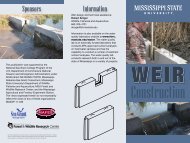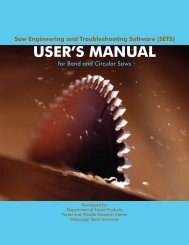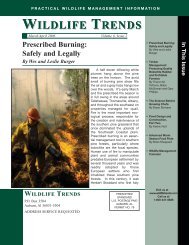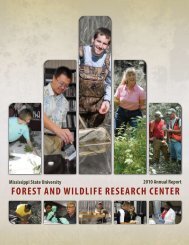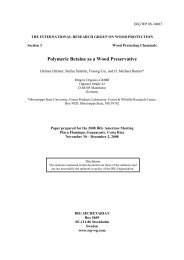Past, Present, and Future of the Wood Preservation Industry
Past, Present, and Future of the Wood Preservation Industry
Past, Present, and Future of the Wood Preservation Industry
You also want an ePaper? Increase the reach of your titles
YUMPU automatically turns print PDFs into web optimized ePapers that Google loves.
F E A T U R E<br />
<strong>Past</strong>, <strong>Present</strong>, <strong>and</strong><br />
<strong>Future</strong> <strong>of</strong> <strong>the</strong> <strong>Wood</strong><br />
<strong>Preservation</strong> <strong>Industry</strong><br />
by<br />
Michael H. Freeman,<br />
Todd F. Shupe,<br />
Richard P. Vlosky,<br />
<strong>and</strong> H.M. Barnes<br />
<strong>Wood</strong> is a<br />
renewable<br />
natural<br />
resource that<br />
typically is<br />
preservative<br />
treated to<br />
ensure structural<br />
integrity in<br />
many exterior<br />
applications.<br />
Preservative treatment <strong>of</strong> wood has a long history<br />
in <strong>the</strong> United States <strong>and</strong> throughout <strong>the</strong> world.<br />
Even <strong>the</strong> early settlers to <strong>the</strong> New World in <strong>the</strong> 17th<br />
century used wood preservatives to protect homes<br />
<strong>and</strong> o<strong>the</strong>r structures.<br />
The treated wood industry in <strong>the</strong> United States<br />
is evolving as new products emerge, technology<br />
advances, <strong>and</strong> environmental concerns increase.<br />
Recently, chromated copper arsenate (CCA) preservative-treated<br />
wood has been a frequent subject in<br />
<strong>the</strong> national news. A voluntary phase-out <strong>of</strong> CCAtreated<br />
wood for non-industrial uses has increased<br />
<strong>the</strong> attention on new-generation, arsenic-free preservatives.<br />
In a recent feature article in <strong>the</strong> Forest<br />
Products Journal, Evans (2003) discussed new<br />
preservative systems, including copper- <strong>and</strong> zincbased<br />
<strong>and</strong> o<strong>the</strong>r metal systems, metal-free systems,<br />
treatment technologies, wood modification, <strong>and</strong> natural<br />
protection systems. This article examines <strong>the</strong><br />
past, present, <strong>and</strong> future <strong>of</strong> preservative-treated<br />
wood with an emphasis on issues in <strong>the</strong> marketplace<br />
<strong>and</strong> treated wood use policy.<br />
The <strong>Past</strong><br />
The history <strong>of</strong> humankind is closely intertwined<br />
with wood utilization. Some <strong>of</strong> <strong>the</strong> earliest uses <strong>of</strong><br />
wood were for fuel for heating <strong>and</strong> cooking. Even<br />
today, this accounts for <strong>the</strong> highest dem<strong>and</strong> <strong>and</strong> use<br />
<strong>of</strong> wood in many developing countries. A period <strong>of</strong><br />
significant advances in industrial processing<br />
occurred during <strong>the</strong> Industrial Revolution. Among<br />
<strong>the</strong>se advances in <strong>the</strong> United States was <strong>the</strong> construction<br />
<strong>of</strong> trans-continental railroads, which created<br />
<strong>the</strong> need for crossties <strong>and</strong> switch ties. As industrial<br />
technology advanced, wood was used more frequently<br />
in exterior structural applications. <strong>Wood</strong><br />
species that did not possess inherent decay resistance<br />
properties failed in service due to biological<br />
attack, creating a need for preservative-treated<br />
wood. Several historical treatises on wood preservation<br />
can be found in <strong>the</strong> literature (Hunt <strong>and</strong><br />
8 OCTOBER 2003
Garratt 1967, Graham 1973, Wilkinson 1979, Barnes<br />
<strong>and</strong> Murphy 1995).<br />
The earliest U.S. patent for a wood preservative<br />
was that issued by <strong>the</strong> Province <strong>of</strong> South Carolina to<br />
Dr. Wm. Crook in 1716 for “. . . Oyle or Spirit <strong>of</strong> Tarr<br />
. . .” In <strong>the</strong> 1700s, mercuric chloride <strong>and</strong> copper sulfate<br />
were first recommended, while zinc chloride<br />
was recommended as a wood preservative in 1815. A<br />
major development in wood preservation history<br />
was <strong>the</strong> use <strong>of</strong> coal-tar creosote, which was patented<br />
in 1836 by Moll, in a pressure impregnation<br />
process patented by John Be<strong>the</strong>ll in 1838. Known as<br />
<strong>the</strong> Be<strong>the</strong>ll, or full-cell, process, it was <strong>the</strong> first major<br />
use <strong>of</strong> pressure for wood treating <strong>and</strong> remains <strong>the</strong><br />
basis <strong>of</strong> most modern wood treating operations. The<br />
process utilizes an initial vacuum period followed by<br />
filling <strong>of</strong> <strong>the</strong> cylinder with preservative <strong>and</strong> application<br />
<strong>of</strong> a pressure period to inject <strong>the</strong> preservative.<br />
A modern-day modification called <strong>the</strong> modified fullcell<br />
utilizes an initial vacuum <strong>of</strong> lower intensity <strong>and</strong><br />
shorter duration along with a final vacuum period.<br />
In 1847, a similar pressure system was used with<br />
zinc chloride in what would be called <strong>the</strong> Burnett<br />
treatment.<br />
The Boucherie Process developed in 1839 provided<br />
<strong>the</strong> basis for modern-day sap displacement<br />
methods such as <strong>the</strong> SlurrySeal® Process,<br />
PresCap®, <strong>and</strong> Gewecke methods. In 1874, Julius<br />
Rütgers <strong>of</strong> Mannheim, Germany, developed a<br />
process for treating wood with zinc chloride <strong>and</strong> creosote,<br />
which was later modified by J.B.Card (Hunt<br />
<strong>and</strong> Garratt 1967) in 1906 in <strong>the</strong> United States <strong>and</strong><br />
used until <strong>the</strong> mid-1920s to treat crossties. O<strong>the</strong>r<br />
full-cell treatments developed in <strong>the</strong> late 1800s to<br />
early 1900s, but no longer in use, include <strong>the</strong><br />
Allardyce treatment, Creoaire treatment, <strong>and</strong> <strong>the</strong><br />
Wellhouse method. In 1884, Boulton published his<br />
classic work “On <strong>the</strong> Antiseptic Treatment <strong>of</strong><br />
Timber,” which provided <strong>the</strong> basis for <strong>the</strong> boultonizing<br />
process for seasoning wood.<br />
The high price <strong>of</strong> oil made <strong>the</strong> creosote process<br />
expensive, so an empty-cell process was developed<br />
by Max Rüping <strong>of</strong> Germany, <strong>and</strong> patented in 1902.<br />
This process utilizes an initial application <strong>of</strong> air pressure<br />
(usually 30 to 50 psig) before filling <strong>the</strong> cylinder<br />
<strong>and</strong> applying a higher pressure (usually 100 psig<br />
above <strong>the</strong> initial air pressure) to inject <strong>the</strong> preservative.<br />
After release <strong>of</strong> pressure, <strong>the</strong> excess preservative<br />
in <strong>the</strong> cell lumen is “kicked back,” resulting in a<br />
much lower retention than <strong>the</strong> conventional full-cell<br />
treatment. An extended steam flash <strong>and</strong> vacuum<br />
period applied after removal <strong>of</strong> preservative solution<br />
completes <strong>the</strong> process. This step reduces <strong>the</strong><br />
amount <strong>of</strong> entrapped air <strong>and</strong> hence bleeding <strong>of</strong><br />
preservative, yielding a much cleaner treatment. A<br />
second empty-cell treatment patented by C.B. Lowry<br />
Creosote-treated wood products have been instrumental<br />
in <strong>the</strong> development <strong>of</strong> <strong>the</strong> U.S. railroad industry.<br />
in 1906 utilizes atmospheric pressure as <strong>the</strong> initial<br />
air pressure. Both processes provide for impregnation<br />
<strong>of</strong> wood with a relatively large amount <strong>of</strong> creosote<br />
<strong>and</strong> subsequent withdrawal <strong>of</strong> part <strong>of</strong> <strong>the</strong> oil,<br />
giving a smaller final retention <strong>of</strong> preservative than<br />
<strong>the</strong> Be<strong>the</strong>ll Process. The process is used when deeper<br />
penetration but less retention is required.<br />
In <strong>the</strong> United States, <strong>the</strong> first Be<strong>the</strong>ll-Process<br />
plant was built in 1865 in Somerset, Massachusetts.<br />
The first commercial plant for waterborne salt treatments<br />
was built in 1848 in Lowell, Massachusetts,<br />
for Kyanizing (soaking in mercuric chloride) timbers.<br />
The advent <strong>of</strong> modern timber preservation in<br />
<strong>the</strong> United States is linked to <strong>the</strong> railroads <strong>and</strong> <strong>the</strong><br />
production <strong>of</strong> crossties by <strong>the</strong> L & N Railroad at a<br />
plant in West Pascagoula, Mississippi, in 1875.<br />
Many modifications to <strong>the</strong> basic full- <strong>and</strong> emptycell<br />
processes have been used to treat wood. In<br />
Australasia, <strong>the</strong> Oscillating Pressure Method (OPM),<br />
a method employing rapid cyclical oscillation<br />
between vacuum <strong>and</strong> pressure, has been used to<br />
treat refractory wood species. A multi-Lowry<br />
process, <strong>the</strong> Alternating Pressure Method (APM),<br />
was also developed to treat green or partially seasoned<br />
wood with CCA. The High Pressure (HP)<br />
method was developed in Australia to treat crossties<br />
at pressures as high as 1,000 psig. The Pulsation<br />
Process is similar to <strong>the</strong> APM Process except that<br />
<strong>the</strong> pressure is never fully reduced to atmospheric<br />
during <strong>the</strong> cycle <strong>and</strong> <strong>the</strong> pressure is increased during<br />
each oscillation. In Sc<strong>and</strong>inavia, <strong>the</strong> use <strong>of</strong> an<br />
overlaying oil treatment on wood treated with waterborne<br />
preservatives constitutes <strong>the</strong> Royal Process.<br />
In <strong>the</strong> United States, <strong>the</strong> MSU Process was developed<br />
to treat wood with CCA using an empty-cell<br />
cycle while providing for in situ fixation <strong>of</strong> <strong>the</strong><br />
preservative components. The Multiple-Phase<br />
Pressure (MPP) Process is very similar to <strong>the</strong> fixation<br />
mode exemplified in <strong>the</strong> MSU Process (Nasheri<br />
FOREST PRODUCTS JOURNAL Vol. 53, No. 10 9
et al. 1999). This system, specifically developed for<br />
CCA in New Zeal<strong>and</strong>, requires a minimum <strong>of</strong> equipment<br />
<strong>and</strong> poses an interesting option for <strong>the</strong> future<br />
<strong>of</strong> CCA. One problem with this system is <strong>the</strong> potential<br />
for sludging. The MCI Process utilizes a heated<br />
expansion bath on <strong>the</strong> end <strong>of</strong> a conventional emptycell<br />
process to fix copper in wood treated with copper<br />
carboxylate preservatives. O<strong>the</strong>r approaches,<br />
notably <strong>the</strong> Cellon® <strong>and</strong> Dow Processes, utilized a<br />
change in carrier systems to obtain clean, non-oily<br />
treatments with pentachlorophenol.<br />
The Vacuum Process is used for some millwork<br />
applications, <strong>and</strong> is also employed to produce very<br />
inexpensive fence posts. Many vacuum plants located<br />
in Missouri use vacuum only <strong>and</strong> regularly<br />
achieve a minimum <strong>of</strong> 67 percent <strong>of</strong> <strong>the</strong> desired<br />
retention <strong>and</strong> penetration <strong>of</strong> most woods as specified<br />
by <strong>the</strong> American <strong>Wood</strong>-Preservers’ Association<br />
(AWPA). A vacuum-only plant can be built for less<br />
than $100,000, including concrete work. The Double<br />
Vacuum Process is used almost exclusively for millwork/joinery.<br />
It consists <strong>of</strong> two vacuum periods in<br />
which <strong>the</strong> treating fluid, usually AWPA Type C or<br />
LOSP, can be used to successfully penetrate <strong>the</strong><br />
small dimension pieces. The second vacuum allows<br />
<strong>the</strong> wood to partially equalize in order to be ready to<br />
receive more fluid.<br />
Copper naph<strong>the</strong>nate has been used as a wood<br />
preservative since 1889. It was first used in Germany<br />
<strong>and</strong> has been in commercial use since 1911. It was<br />
recognized in <strong>the</strong> AWPA st<strong>and</strong>ards in 1949, but did<br />
not gain wide use for pressure treatments until <strong>the</strong><br />
late 1980s, when regulatory activities stimulated<br />
interest in <strong>the</strong> product because <strong>of</strong> its general use<br />
classification. Soon <strong>the</strong>reafter, copper naph<strong>the</strong>nate<br />
began to be used for cross arms, bridges, utility<br />
poles, fence posts, <strong>and</strong> lumber. Copper naph<strong>the</strong>nate<br />
is also used in non-pressure applications such as<br />
field-applied preservatives <strong>and</strong> coatings.<br />
CCA was patented by Kamesam in 1938 <strong>and</strong> is<br />
<strong>the</strong> major preservative in use today. Three forms<br />
were st<strong>and</strong>ardized by AWPA: type A in 1953, type B<br />
in 1964, <strong>and</strong> type C in 1969, with type C dominating<br />
<strong>the</strong> marketplace today. The three types differ in<br />
<strong>the</strong>ir ratio <strong>of</strong> Cu:Cr:As. An additional acidic system,<br />
acid copper chromate (Celcure) was patented in<br />
1928 by Gunn <strong>and</strong> was st<strong>and</strong>ardized in <strong>the</strong> 1950s<br />
The o<strong>the</strong>r major arsenical preservative, ammoniacal<br />
copper arsenate (ACA), was st<strong>and</strong>ardized in<br />
1950. Known under <strong>the</strong> trade name Chemonite, it<br />
was modified by replacing some <strong>of</strong> <strong>the</strong> arsenic with<br />
zinc in <strong>the</strong> 1980s; this formulation is known as ACZA.<br />
Because ACA <strong>and</strong> ACZA are alkaline <strong>and</strong> imbue <strong>the</strong><br />
wood with vivid color, <strong>the</strong>y have generally been<br />
used for industrial products <strong>and</strong> are used to treat<br />
refractory western conifers.<br />
Oriented str<strong>and</strong>board mat ready for pressing<br />
During <strong>the</strong> early 1930s, Dr. Carl Schmittutz <strong>of</strong> Bad<br />
Kissingen, Germany, organized <strong>the</strong> Osmose <strong>Wood</strong><br />
Impregnating Company <strong>of</strong> Leipzig, Germany. The<br />
original Osmose patents described a preservative<br />
process using sodium fluoride, potassium bichromate,<br />
sodium arsenate, <strong>and</strong> dinitrophenol. This<br />
preservative was known in <strong>the</strong> industry as FCAP.<br />
Penetration <strong>of</strong> preservatives was achieved through<br />
<strong>the</strong> process <strong>of</strong> diffusion or “osmosis” into green<br />
wood or wood <strong>of</strong> high moisture content. One early<br />
commercial use <strong>of</strong> this preservative in <strong>the</strong> United<br />
States was a timber dipping <strong>and</strong> stacking process<br />
used by coal mines (McNamara 1990, Osmose 2003).<br />
Boron compounds <strong>of</strong>fer some <strong>of</strong> <strong>the</strong> most effective<br />
<strong>and</strong> versatile wood preservative systems available<br />
today, combining <strong>the</strong> properties <strong>of</strong> broad-spectrum<br />
efficacy <strong>and</strong> low acute mammalian toxicity.<br />
Products treated with borates include <strong>the</strong> following:<br />
lumber <strong>and</strong> plywood, oriented str<strong>and</strong>board (OSB),<br />
siding, engineered wood, wood-plastic composites,<br />
millwork, windows, doors, furniture, telephone<br />
poles, railroad ties, <strong>and</strong> log homes (U.S. Borax 2003).<br />
Remedial systems using boron are common in <strong>the</strong><br />
marketplace.<br />
Ano<strong>the</strong>r historically important preservative is<br />
pentachlorophenol (penta), which is a crystalline<br />
chemical compound (C 6 Cl 5 OH) formed by <strong>the</strong> reaction<br />
<strong>of</strong> chlorine on phenol. It is a widely used oilborne<br />
preservative. British patent 296,332, issued in<br />
1928 to W. Iwanowski <strong>and</strong> J. Turski, covers <strong>the</strong> use <strong>of</strong><br />
di-, tri-, <strong>and</strong> polychlorinated phenols for wood-preserving<br />
purposes. In 1929 in <strong>the</strong> United States, L.P.<br />
Curtin patented <strong>the</strong> use <strong>of</strong> “chlorine derivatives <strong>of</strong><br />
coal-tar acids <strong>of</strong> higher molecular weight than <strong>the</strong><br />
cresols” (U.S. patent 1,722,323) expressing a preference<br />
for chlorinated phenols. The production <strong>of</strong><br />
chlorinated phenols in <strong>the</strong> United States for wood<br />
preserving experiments did not begin until about<br />
1930 (Hunt <strong>and</strong> Garratt 1967).<br />
10 OCTOBER 2003
The <strong>Present</strong><br />
According to Micklewright (1999) <strong>and</strong> <strong>the</strong> more<br />
recent 2000 Sou<strong>the</strong>rn Forest Products Association<br />
(SFPA) treated wood survey (Wade <strong>and</strong> Mason 2002)<br />
CCA (<strong>and</strong> small amounts <strong>of</strong> ACZA in <strong>the</strong> West <strong>and</strong><br />
Midwest) are used to protect 80 percent <strong>of</strong> <strong>the</strong> lumber<br />
that is preservative treated for residential applications.<br />
About 7.63 billion board feet (BBF), or 44<br />
percent <strong>of</strong> <strong>the</strong> 13 BBF <strong>of</strong> sou<strong>the</strong>rn yellow pine (SYP)<br />
lumber produced, is pressure treated with some type<br />
<strong>of</strong> preservative system. CCA is inexpensive, highly<br />
effective, <strong>and</strong> poses negligible risk when used for residential<br />
<strong>and</strong> garden construction, outdoor furniture,<br />
<strong>and</strong> playground equipment. Regardless <strong>of</strong> CCA’s<br />
excellent performance <strong>and</strong> environmental record,<br />
public perceptions regarding potential arsenic exposure<br />
have led to a voluntary withdrawal <strong>of</strong> CCA-treated<br />
wood from <strong>the</strong> residential market (with <strong>the</strong><br />
notable exception <strong>of</strong> wood treated for permanent<br />
wood foundations) by 2004 in <strong>the</strong> United States <strong>and</strong><br />
in Canada. This represents a potential market share<br />
loss <strong>of</strong> 68 percent for CCA-treated wood. CCA has<br />
already been limited in over 26 o<strong>the</strong>r countries. Most<br />
European countries have already limited CCA use<br />
with fur<strong>the</strong>r restrictions being considered. Japan has<br />
changed to preservatives that do not contain ei<strong>the</strong>r<br />
arsenic or chromium. Currently, three commercially<br />
available non-arsenical systems appear poised to<br />
replace CCA for residential applications: alkaline<br />
copper quat (ACQ), amine copper azole (CA), <strong>and</strong><br />
copper bis-(N-cyclohexyldiazeniumdioxy) (Cu-HDO<br />
or copper xyligen). Excellent technical discussions <strong>of</strong><br />
<strong>the</strong> newer preservative systems <strong>and</strong> <strong>the</strong>ir properties<br />
<strong>and</strong> applications can be found in <strong>the</strong> literature<br />
(Nicholas <strong>and</strong> Shultz 1995, Goodell et al. 2003).<br />
One <strong>of</strong> <strong>the</strong> most exciting new treating technologies<br />
is based on <strong>the</strong> suggestion by Scheurch (1968)<br />
Sou<strong>the</strong>rn yellow pine timbers being prepared for<br />
treatment.<br />
Treated lumber ready for shipment.<br />
that treatment in <strong>the</strong> vapor phase could mitigate<br />
problems that occur when treating with liquids. All<br />
treatments in <strong>the</strong> liquid phase depend upon <strong>the</strong><br />
movement <strong>of</strong> liquid preservative into <strong>the</strong> wood. Two<br />
problems must be overcome in order to get deep,<br />
uniform treatment. First, tension forces at <strong>the</strong> liquidair<br />
<strong>and</strong> liquid-wood interfaces must be overcome.<br />
Secondly, transverse movement is dictated by <strong>the</strong><br />
permeability <strong>of</strong> pit membranes. Gas phase treatment<br />
would seem to eliminate both <strong>of</strong> <strong>the</strong>se major problems.<br />
The possibility <strong>of</strong> putting protectants into <strong>the</strong><br />
cell wall using such an approach would mean that<br />
smaller amounts <strong>of</strong> biocides would be needed, thus<br />
fur<strong>the</strong>r minimizing <strong>the</strong> impact on <strong>the</strong> environment.<br />
Gas-phase treatments have been used extensively for<br />
remedial treatment <strong>of</strong> wood in service (Morrell <strong>and</strong><br />
Corden 1986, Morrell et al. 1986), but efforts to modify<br />
wood using gaseous reagents have met with only<br />
moderate success (McMillin 1963, Barnes et al. 1969).<br />
Reaction with alkylene oxides has yielded some<br />
decay <strong>and</strong> termite resistance (Rowell <strong>and</strong> Gutzmer<br />
1975, Rowell et al. 1979).<br />
Vapor phase boron treatments have been<br />
applied as primary treatments for wood <strong>and</strong> woodbased<br />
materials (Murphy et al. 2002). In this treatment,<br />
trimethyl borate is heated <strong>and</strong> introduced into<br />
an evacuated cylinder containing dried wood or engineered<br />
composites. Diffusion is rapid <strong>and</strong> penetration<br />
is complete. The main advantages <strong>of</strong> <strong>the</strong> process<br />
are <strong>the</strong> speed <strong>and</strong> cleanliness <strong>of</strong> treatment <strong>and</strong> <strong>the</strong><br />
potential for drying, treating, <strong>and</strong> conditioning in a<br />
single vessel. The supercritical CO 2 fluid treatments<br />
presented by Evans (2003) <strong>and</strong> based on ongoing<br />
research in Japan <strong>and</strong> <strong>the</strong> United States take vapor<br />
phase treatments one step fur<strong>the</strong>r by eliminating any<br />
problems caused by <strong>the</strong> phase <strong>of</strong> <strong>the</strong> carrier solvent.<br />
O<strong>the</strong>r approaches to improving treatability, especially<br />
for refractory species, include mechanical, biological,<br />
<strong>and</strong> microwave pretreatments. A recently<br />
patented mechanical stressing process (Amburgey et<br />
al. 2000) may have application in <strong>the</strong> future.<br />
FOREST PRODUCTS JOURNAL Vol. 53, No. 10 11
Mold<br />
<strong>Future</strong> Challenges<br />
Mold growth in homes has not necessarily<br />
increased in recent years, but new court cases<br />
involving mold, sensationalistic media coverage,<br />
<strong>and</strong> publication <strong>of</strong> questionable scientific research<br />
have increased public awareness <strong>of</strong> <strong>the</strong> issue<br />
(Robbins <strong>and</strong> Morrell 2003). Much <strong>of</strong> <strong>the</strong> recent concern<br />
about mold was aroused after several articles<br />
on <strong>the</strong> subject appeared in scientific journals. One <strong>of</strong><br />
<strong>the</strong> most widely publicized articles was written by<br />
researchers from <strong>the</strong> U.S. Centers for Disease<br />
Control (CDC). They reported that in 1993 <strong>the</strong>re<br />
were 10 cases <strong>of</strong> acute pulmonary hemorrhage/<br />
hemosiderosis in infants, some <strong>of</strong> whom died, that<br />
was thought to be linked to <strong>the</strong> mold Stachybotrys<br />
chartarum (also known as Stachybotrys atra)<br />
(Robbins <strong>and</strong> Morrell 2003). It was later determined<br />
<strong>the</strong>re was no evidence or scientific pro<strong>of</strong> that<br />
Stachybotrys caused <strong>the</strong> health problems in <strong>the</strong>se<br />
infants (CDC 2000a). In fact, <strong>the</strong> CDC notes: “At present<br />
<strong>the</strong>re is no test that proves an association<br />
between Stachybotrys chartarum (Stachybotrys atra)<br />
<strong>and</strong> particular health symptoms.”(CDC 2000b) It<br />
appears as if good moisture control could solve most<br />
mold problems. The mold issue has only become a<br />
problem because <strong>the</strong> public now perceives it as a<br />
severe health threat, <strong>and</strong> attorneys are bringing <strong>the</strong><br />
issue before juries to seek large judgments.<br />
Formosan Subterranean Termites<br />
The Formosan subterranean termite (FST) has<br />
done tremendous damage to cellulose-based products.<br />
The majority <strong>of</strong> <strong>the</strong> damage has occurred in<br />
<strong>the</strong> U.S. South <strong>and</strong> Hawaii. It is estimated that <strong>the</strong><br />
FST causes some $300 million in damage per year in<br />
<strong>the</strong> Greater New Orleans Metropolitan Area<br />
(McClain 1999). In 1993, <strong>the</strong> <strong>Wood</strong> Protection<br />
Council <strong>of</strong> <strong>the</strong> National Institute <strong>of</strong> Building Sciences<br />
(NIBS) estimated <strong>the</strong> annual cost <strong>of</strong> replacing wood<br />
damaged by <strong>the</strong> FST to be $2 billion, up from $750<br />
million in 1988 (Ring 1999). These tremendous losses<br />
caused by <strong>the</strong> FST have renewed interest <strong>and</strong><br />
attention in <strong>the</strong> research area <strong>of</strong> wood durability.<br />
The public is now dem<strong>and</strong>ing preservatives that<br />
have a high degree <strong>of</strong> efficacy against <strong>the</strong> FST <strong>and</strong><br />
o<strong>the</strong>r wood-destroying organisms, while also requiring<br />
that <strong>the</strong> preservatives are safe.<br />
Engineered <strong>Wood</strong> Composites<br />
Most prognosticators agree that engineered<br />
wood composites (EWC) will be <strong>the</strong> wave <strong>of</strong> <strong>the</strong><br />
future. These products pose special problems if we<br />
are to increase <strong>the</strong>ir durability. The successful marriage<br />
<strong>of</strong> a biocide <strong>and</strong> EWC must consider <strong>the</strong> effect<br />
<strong>of</strong> <strong>the</strong> biocide on <strong>the</strong> chemical interaction with <strong>the</strong><br />
resin used, <strong>the</strong> physical properties <strong>of</strong> <strong>the</strong> composite,<br />
<strong>the</strong> distribution <strong>of</strong> biocide within <strong>the</strong> product,<br />
<strong>the</strong> efficacy <strong>of</strong> <strong>the</strong> treated composite, <strong>and</strong> <strong>the</strong> effect<br />
<strong>of</strong> manufacture on EWC properties. Newer treatment<br />
technologies will need to be developed <strong>and</strong><br />
refined <strong>and</strong> <strong>the</strong> workplace environment will need to<br />
be considered.<br />
Mold <strong>and</strong> decay are <strong>the</strong> result <strong>of</strong> moisture that accumulated<br />
in this wall.<br />
Photo by T.L. Amburgey, Mississippi State University<br />
<strong>Wood</strong> damaged by <strong>the</strong> Formosan subterranean termite is<br />
surrounding carton material produced by <strong>the</strong> termites.<br />
Photo by T.L. Amburgey, Mississippi State University<br />
12 OCTOBER 2003
O<strong>the</strong>r Considerations<br />
It has been suggested that companies that are<br />
considering developing <strong>and</strong> marketing environmental<br />
technologies such as ACQ, CA, <strong>and</strong> Cu-HDO can’t<br />
simply tout environmental advantages. They must<br />
show that <strong>the</strong> new alternative does <strong>the</strong> job just as<br />
well for <strong>the</strong> same cost or less. The companies also<br />
have to convince suppliers <strong>and</strong> distributors to make<br />
changes to transition to this alternative. Fur<strong>the</strong>r,<br />
<strong>the</strong>y must also work with wood treaters to install<br />
new equipment for new generation systems <strong>and</strong><br />
<strong>the</strong>y must convince wholesale <strong>and</strong> retail distributors<br />
to carry <strong>the</strong> new product line.<br />
There is a threat that wood will lose market<br />
share to substitutes. Areas that have been greatly<br />
impacted by <strong>the</strong> FST are <strong>of</strong>ten very vulnerable to<br />
this threat. For example, <strong>the</strong> area in <strong>and</strong> around New<br />
Orleans, Louisiana, has been targeted by <strong>the</strong> North<br />
American Steel Alliance, Inc. for a new marketing<br />
campaign. Some homeowners who have had serious<br />
structural damage to <strong>the</strong>ir houses have vowed not<br />
to rebuild with wood. The North American Steel<br />
Alliance, Inc., is <strong>of</strong>fering a guarantee against insects<br />
<strong>and</strong> fungi, as well as emphasizing that <strong>the</strong>re is no<br />
arsenic exposure with <strong>the</strong>ir product.<br />
The Need for Public Education<br />
In 2002, <strong>the</strong> Environmental Protection Agency<br />
(EPA) transition away from CCA-treated wood for<br />
non-industrial uses had been announced but not yet<br />
implemented. At that time, homebuilders were surveyed<br />
to elicit perceptions regarding treated wood<br />
(Vlosky <strong>and</strong> Shupe, in review). Respondents were<br />
asked if <strong>the</strong>y were aware <strong>of</strong> <strong>the</strong> (at that time) pending<br />
EPA change. Fifty-eight percent <strong>of</strong> respondents<br />
fell on <strong>the</strong> “not aware” side <strong>of</strong> <strong>the</strong> midpoint <strong>of</strong> <strong>the</strong> 5-<br />
point awareness scale used in this question, with 43<br />
percent not being aware at all. Only 5 percent <strong>of</strong><br />
respondents were “very aware.” As a follow-up question,<br />
respondents were asked what effect <strong>the</strong>y<br />
expected from a switch to “new generation” preservatives<br />
for both <strong>the</strong>m <strong>and</strong> <strong>the</strong>ir customers. Fortynine<br />
percent did not know what <strong>the</strong> effect might be.<br />
But 53 percent <strong>of</strong> respondents said that <strong>the</strong>y had<br />
concerns about using treated wood in homes <strong>the</strong>y<br />
build. The greatest concern is <strong>the</strong> perceived health<br />
risk followed by a closely related concern: long-term<br />
exposure to treated wood. One-third <strong>of</strong> <strong>the</strong> respondents<br />
were not familiar with treated wood consumer<br />
information sheets. Nearly a third <strong>of</strong> respondents<br />
believed that some types <strong>of</strong> treated wood are safer<br />
than o<strong>the</strong>rs <strong>and</strong> over half were unsure.<br />
A companion study surveyed owners <strong>of</strong> newly<br />
built homes regarding <strong>the</strong>ir attitudes toward treated<br />
wood (Vlosky <strong>and</strong> Shupe 2002). In that study, it was<br />
found that only 5 percent <strong>of</strong> respondents had a negative<br />
perception <strong>of</strong> treated wood <strong>and</strong> 75 percent<br />
were willing to use treated wood in <strong>the</strong>ir homes. Of<br />
those who were unwilling to use treated wood in<br />
<strong>the</strong>ir homes, health concerns were <strong>the</strong> major reason.<br />
There was a general misunderst<strong>and</strong>ing among<br />
respondents regarding treated wood: 49 percent <strong>of</strong><br />
respondents reported no underst<strong>and</strong>ing <strong>of</strong> <strong>the</strong> concept<br />
<strong>of</strong> wood treating; 45 percent didn’t believe that<br />
using treated wood could reduce deforestation; 79<br />
percent reported that <strong>the</strong>y did not have knowledge<br />
<strong>of</strong> treated wood consumer information sheets; 60<br />
percent desired additional information on treated<br />
wood. Only 27 percent <strong>of</strong> respondents trusted<br />
claims made by treated wood manufacturers, indicating<br />
that <strong>the</strong>re is work to be done in this arena.<br />
From <strong>the</strong>se two studies, it is evident that U.S.<br />
homebuilders <strong>and</strong> homeowners currently use <strong>and</strong><br />
have plans to continue to use treated wood.<br />
However, <strong>the</strong>re is a general misunderst<strong>and</strong>ing <strong>of</strong> <strong>the</strong><br />
properties <strong>of</strong> treated wood, which may be <strong>the</strong> cause<br />
<strong>of</strong> consumer safety concerns <strong>and</strong> <strong>the</strong>ir lack <strong>of</strong> trust<br />
<strong>of</strong> information coming from <strong>the</strong> wood treating<br />
industry. The treated wood industry is currently<br />
not providing enough education <strong>and</strong> promotion to<br />
homebuilders <strong>and</strong> homeowners. If <strong>the</strong>se studies<br />
<strong>and</strong> <strong>the</strong> previous issues mentioned tell us anything,<br />
<strong>the</strong>y should indicate <strong>the</strong> clear need for good information<br />
based on science <strong>and</strong> not innuendo or perception.<br />
What Does <strong>the</strong> <strong>Future</strong> Hold?<br />
The future for wood preservation looks very<br />
bright indeed! We are already seeing many new<br />
wood substitutes for solid treated wood, including<br />
engineered wood composites like wood-plastic composites<br />
<strong>and</strong> products such as preserved oriented<br />
str<strong>and</strong>board (OSB), laminated veneer lumber (LVL),<br />
<strong>and</strong> parallel str<strong>and</strong> lumber (PSL.) All <strong>of</strong> <strong>the</strong>se products<br />
will need to use both new <strong>and</strong> existing preserving<br />
technologies to prevent <strong>the</strong> colonization by<br />
decay organisms, <strong>and</strong> infestation by wood-destroying<br />
insects. Even wood-plastic composites, which<br />
are still 40 to 60 percent wood fiber, will need to<br />
incorporate active biocides to insure that <strong>the</strong>y will<br />
be long-term useful building materials. Evaluation <strong>of</strong><br />
wood-plastic composites already in service has<br />
found that those without biocide incorporation have<br />
exhibited both mold <strong>and</strong> fruiting bodies after exterior<br />
exposure.<br />
FOREST PRODUCTS JOURNAL Vol. 53, No. 10 13
Many new methods <strong>of</strong> wood preservation will<br />
include innovative processes. We have just begun<br />
<strong>the</strong> possibility <strong>of</strong> modifying wood properties to perform<br />
such needed tasks as dimensional stability to<br />
minimize <strong>the</strong> effects <strong>of</strong> moisture <strong>and</strong> moisture-temperature<br />
changes. Dimensional stability has long<br />
been <strong>the</strong> holy grail <strong>of</strong> wood treatments <strong>and</strong> will likely<br />
continue to be so into <strong>the</strong> future. A few <strong>of</strong> <strong>the</strong> new<br />
processes (e.g., supercritical fluid treatment) will<br />
allow us to broach <strong>the</strong> physical <strong>and</strong> mechanical limitations<br />
<strong>of</strong> treating with conventional liquid treatments<br />
by exploring <strong>the</strong> nearly limitless possibilities<br />
<strong>of</strong> treating with a liquid that penetrates a substrate<br />
like a gas, or using vapor phase technology to<br />
impregnate wood with a diffusible product, like<br />
boron, without significantly altering <strong>the</strong> dimensional<br />
properties <strong>of</strong> <strong>the</strong> wood.<br />
The public perception <strong>of</strong> potential arsenic exposure<br />
is having an effect, but as long as arsenical chemistry<br />
is allowed for wood preservation, we will continue<br />
to see research that focuses on possible methods<br />
<strong>of</strong> minimizing leaching <strong>of</strong> arsenic into <strong>the</strong> environment.<br />
Recently, we have also begun to see environmental<br />
pressure on benign elements, like copper.<br />
Copper-based pesticides have begun to experience<br />
some environmental pressure in certain areas <strong>of</strong> <strong>the</strong><br />
world due to aquatic toxicity, although copper continues<br />
to be <strong>the</strong> most widely used fungicide in <strong>the</strong><br />
world for protection <strong>of</strong> both wood <strong>and</strong> agricultural<br />
crops. Pr<strong>of</strong>essionals in <strong>the</strong> field <strong>of</strong> wood preservation<br />
feel that copper-based preservation technology will<br />
continue to be dominant for water-based treatment<br />
for at least ano<strong>the</strong>r decade, but <strong>the</strong> development <strong>and</strong><br />
use <strong>of</strong> all-organic biocides continue to be <strong>of</strong> interest<br />
to all those in wood preservation research.<br />
Summary <strong>and</strong> Conclusions<br />
Modern wood preservation is barely two centuries<br />
old. <strong>Wood</strong>, being <strong>the</strong> most versatile building<br />
material that has ever been utilized, will continue to<br />
need protection from degrading factors, like decay,<br />
insects, <strong>and</strong> fire. Significant growth in this industry<br />
has been seen in every single decade since Be<strong>the</strong>ll<br />
originally impregnated timber with creosote in <strong>the</strong><br />
1830s.<br />
The use <strong>of</strong> newer process technologies holds<br />
promise for new wood preservatives, <strong>and</strong> breaks<br />
ground for modern advances in commercial production<br />
plants, <strong>and</strong> innovation in research opportunities.<br />
There is an increasing need to educate <strong>the</strong> consumer<br />
regarding new wood-treating chemistries <strong>and</strong><br />
new products.<br />
By December 31, 2003, <strong>the</strong> voluntary cancellation<br />
<strong>of</strong> arsenically treated wood for residential <strong>and</strong><br />
consumer use in <strong>the</strong> United States <strong>and</strong> Canada will<br />
take effect. These products will likely be replaced by<br />
more expensive preservative systems. Therefore,<br />
while <strong>the</strong> actual volume <strong>of</strong> wood being treated may<br />
decrease due to product substitution (e.g., plastics),<br />
total market dollar volume will increase because <strong>the</strong><br />
new alternatives are more expensive.<br />
A recent survey showed that most <strong>of</strong> <strong>the</strong> sou<strong>the</strong>rn<br />
pine lumber produced in <strong>the</strong> United States is<br />
pressure-treated with wood preservative compounds.<br />
The widespread use <strong>of</strong> wood preservatives<br />
greatly extends <strong>the</strong> life <strong>of</strong> wood products <strong>and</strong> allows<br />
us to reduce <strong>the</strong> environmental impact <strong>of</strong> cutting<br />
more forestl<strong>and</strong>. The old forest products saying <strong>of</strong><br />
“conserve <strong>the</strong> forests by preserving <strong>the</strong> wood” can<br />
sometimes best summarize it.<br />
The authors, are respectively, <strong>Wood</strong> Scientist, 7421<br />
Hunters Tree Cove, Memphis, TN 38125; Associate<br />
Pr<strong>of</strong>essor, <strong>and</strong> Pr<strong>of</strong>essor <strong>and</strong> Director, Louisiana<br />
Forest Products Development Center, School <strong>of</strong><br />
Renewable Natural Resources, Louisiana State<br />
University Agricultural Center, Baton Rouge, LA 70803;<br />
<strong>and</strong> Pr<strong>of</strong>essor, Forest Products Laboratory, Forest &<br />
Wildlife Research Center, Mississippi State University,<br />
Mississippi State, MS 39762. This article (No. 03-40-<br />
1366) is published with <strong>the</strong> approval <strong>of</strong> <strong>the</strong> Director <strong>of</strong><br />
<strong>the</strong> Louisiana Agricultural Experiment Station.<br />
14 OCTOBER 2003
Literature Cited<br />
Amburgey, T.L., H.M. Barnes, <strong>and</strong> M.G. S<strong>and</strong>ers. 2000.<br />
Application <strong>of</strong> mechanical stress to improve treatability.<br />
US Patent 6,142,198<br />
Barnes, H.M. <strong>and</strong> R.J. Murphy. 1995. <strong>Wood</strong> <strong>Preservation</strong>:<br />
The Classics <strong>and</strong> <strong>the</strong> New Age. Forest Prod. J. 45(9):16-25.<br />
__________, E.T. Choong, <strong>and</strong> R.C. McIlhenny. 1969. Several<br />
vapor phase chemical treatments for dimensional stabilization<br />
<strong>of</strong> wood. Forest Prod. J. 19(3):35-39.<br />
Evans, P. 2003. Emerging technologies in wood protection.<br />
Forest Prod. J. 53(1):14-22.<br />
Goodell, B., D.D. Nicholas, <strong>and</strong> T.P Shultz, eds. 2003, <strong>Wood</strong><br />
deterioration <strong>and</strong> preservation: Advances in our changing<br />
world. ACS Symposium Series 845, Am. Chem. Society,<br />
Washington, DC. 465 pp.<br />
Graham, R.D. 1973. History <strong>of</strong> wood preservation. In: <strong>Wood</strong><br />
Deterioration <strong>and</strong> Its Prevention by Preservative<br />
Treatments. Vol. I. Degradation <strong>and</strong> Protection <strong>of</strong> <strong>Wood</strong>.<br />
D.D. Nicholas, ed. Syracuse Univ. Press, Syracuse, N.Y. pp.<br />
1-30.<br />
Hunt, G.M. <strong>and</strong> G.A.Garratt. 1967. <strong>Wood</strong> preservation.<br />
Third. ed. The American Forestry Series. McGraw–Hill,<br />
New York.<br />
McClain, R. 1999. Builders oppose termite proposal. The<br />
Advocate. November 20, 1999. Page 1a. Baton Rouge, LA.<br />
McMillin, C.W. 1963. Dimensional stabilization <strong>of</strong> wood<br />
with polymerizable vapor <strong>of</strong> ethylene oxide. Forest Prod.<br />
J. 13(2):56-61.<br />
McNamara, W.S. 1990. Historical uses <strong>of</strong> diffusible wood<br />
preservatives in North America. In: Proc. <strong>of</strong> <strong>the</strong> First<br />
Conference on <strong>Wood</strong> Protection With <strong>Wood</strong> Preservatives.<br />
Proc. 47355. Forest Products Society, Madison, WI.<br />
Micklewright, J.T. 1999. <strong>Wood</strong> <strong>Preservation</strong> Statistics 1997.<br />
American <strong>Wood</strong>-Preservers’ Assoc., Granbury, TX.<br />
Morrell, J.J. <strong>and</strong> M.E. Corden. 1986. Controlling wood deterioration<br />
with fumigants: A review. Forest Prod. J.<br />
36(10):26-34<br />
__________, S.M. Smith, M.A. Newbill, <strong>and</strong> R.D. Graham.<br />
1986. Reducing internal <strong>and</strong> external decay <strong>of</strong> untreated<br />
Douglas-fir poles: A field test. Forest Prod. J. 36(4):47-52.<br />
Murphy, R.J., H.M. Barnes, <strong>and</strong> D.J. Dickinson. 2002. Vapor<br />
boron technology. In: Proc. Enhancing <strong>the</strong> Durability <strong>of</strong><br />
Lumber <strong>and</strong> Engineered <strong>Wood</strong> Products. Forest Prod. Soc.,<br />
Madison, WI.<br />
Nasheri, K., H. Pearson, J. Pendlebury, J. Drysdale, <strong>and</strong><br />
M. Hedley. 1999. The multi-phase pressure process:<br />
one-stage CCA treatment <strong>and</strong> fixation process. Forest<br />
Prod. J. 49(10):47-52.<br />
Nicholas, D.D. <strong>and</strong> T.P. Shultz. 1995. Biocides that have<br />
potential as wood preservatives: An overview. In: <strong>Wood</strong><br />
<strong>Preservation</strong> in <strong>the</strong> ‘90s <strong>and</strong> Beyond. Proc. 7308. Forest<br />
Prod. Soc., Madison, WI. pp. 169-179.<br />
Osmose. 2003. www.osmose.com/about/history/<br />
Ring, D. 1999. Need for <strong>the</strong> integrated pest management <strong>of</strong><br />
<strong>the</strong> Formosan subterranean termite. Technical Note. LSU<br />
Agricultural Center, Baton Rouge, LA. 3 pp.<br />
Robbins, C. <strong>and</strong> J.J. Morrell. 2003. Mold, housing <strong>and</strong><br />
wood. Western <strong>Wood</strong> Products Assoc., Portl<strong>and</strong>, OR.<br />
Rowell, R.M. <strong>and</strong> D.I. Gutzmer. 1975. Chemical modification<br />
<strong>of</strong> wood: Reactions <strong>of</strong> alkylene oxides with sou<strong>the</strong>rn<br />
yellow pine wood. <strong>Wood</strong> Sci. 7(3):240-246.<br />
__________, V. Hart, <strong>and</strong> G.R. Esen<strong>the</strong>r. 1979. Resistance <strong>of</strong><br />
alkylene oxide modified sou<strong>the</strong>rn pine to attack by subterranean<br />
termites. <strong>Wood</strong> Sci. 11(4):271-274.<br />
Scheurch, C. 1968. Treatment <strong>of</strong> wood with gaseous<br />
reagents. Forest Prod. J. 18(3):47-53.<br />
U.S. Borax. 2003. www.borax.com/wood<br />
U.S. Centers for Disease Control (CDC). 2000a. Update:<br />
Pulmonary hemorrhage/ hemosiderosis among infants —<br />
Clevel<strong>and</strong>, Ohio, 1993-1996. MMWR March 10, 2000a /<br />
49(09):180-184. CDC, Atlanta, GA.<br />
__________. 2000b. Questions <strong>and</strong> Answers on<br />
Stachybotrys chartarum <strong>and</strong> o<strong>the</strong>r molds. March 9, 2000b.<br />
www.cdc.gov/nceh/asthma/factsheets/molds/default.htm.<br />
Vlosky, R.P. <strong>and</strong> T.F. Shupe. 2002. Homeowner attitudes<br />
<strong>and</strong> preferences for building materials with an emphasis<br />
on treated wood products. Forest Prod. J. 52(7/8):90-95<br />
__________ <strong>and</strong> __________. What do U.S. homebuilders<br />
think about treated wood? Forest Prod. J. (in review).<br />
Wade, R. <strong>and</strong> D, Mason. 2002. The 2000 Treated <strong>Wood</strong> <strong>and</strong><br />
Treated <strong>Wood</strong> Products Statistics Report. Sou<strong>the</strong>rn Forest<br />
Products Assoc., Kenner, LA. 16 pp.<br />
Wilkinson. J.G. 1979. Industrial Timber <strong>Preservation</strong>.<br />
Associated Business Press, London, UK. pp. 532.<br />
FOREST PRODUCTS JOURNAL Vol. 53, No. 10 15



